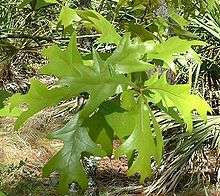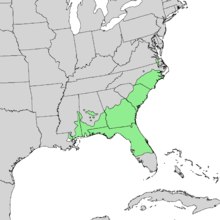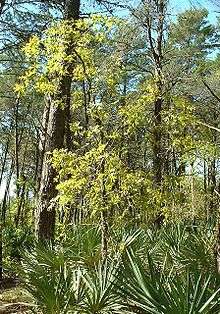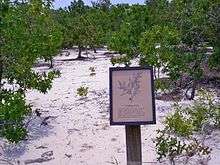Quercus laevis
| Quercus laevis | |
|---|---|
 | |
| American Turkey Oak foliage | |
| Scientific classification | |
| Kingdom: | Plantae |
| Clade: | Angiosperms |
| Clade: | Eudicots |
| Clade: | Rosids |
| Order: | Fagales |
| Family: | Fagaceae |
| Genus: | Quercus |
| Subgenus: | Quercus subg. Quercus |
| Section: | Quercus sect. Lobatae |
| Species: | Q. laevis |
| Binomial name | |
| Quercus laevis | |
 | |
| Quercus laevis native range | |
| Synonyms[1] | |
| |
Quercus laevis, the turkey oak, is a member of the red oak group of oaks. It is native to the southeastern United States, occurring on the coastal plain from Virginia south to central Florida, and west to southeast Louisiana.[2] The name turkey oak derives from the resemblance of the leaves to a turkey's foot.[3] A Turkish and southern European species Quercus cerris is also commonly referred to as Turkey oak, so Quercus laevis is sometimes referred to as American turkey oak to distinguish it from the European species.

Quercus laevis is a small tree, sometimes shrubby, typically only 8–10 metres (26–33 ft) tall, though occasionally reaching 18 metres (59 ft). The leaves are variable in size, mostly 10–17 centimetres (3.9–6.7 in) long but occasionally just 8 centimetres (3.1 in) or as much as 30 centimetres (12 in) long. They have 3–7 slender lobes, deeply incised between the lobes, each lobe with 1–3 bristle teeth at the tip. The acorns are about 20–25 millimetres (0.79–0.98 in) long, and, like other red oaks, take 18 months to mature.[4]

Turkey oak typically grows on poor, thin, dry, rocky or sandy soils where few other oaks other than blackjack oak (Q. marilandica) can thrive. It does not have the beautiful crown form of many oaks, but is nonetheless a valuable tree for growing on infertile, dry, sandy sites. The deeply lobed leaves are also attractive. It associates as an understory tree with longleaf pine and other pine stands on sandy knolls in the southeastern United States.
References
- ↑ "Quercus laevis Walter". World Checklist of Selected Plant Families (WCSP). Royal Botanic Gardens, Kew – via The Plant List.
- ↑ "Quercus laevis". County-level distribution map from the North American Plant Atlas (NAPA). Biota of North America Program (BONAP). 2014.
- ↑ "Turkey oak (Quercus laevis)". Florida Forest Trees. University of Florida. Retrieved February 8, 2010.
- ↑ Nixon, Kevin C. (1997). "Quercus laevis". In Flora of North America Editorial Committee. Flora of North America North of Mexico (FNA). 3. New York and Oxford – via eFloras.org, Missouri Botanical Garden, St. Louis, MO & Harvard University Herbaria, Cambridge, MA.